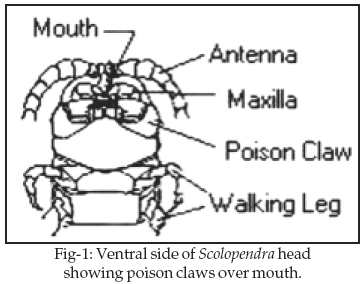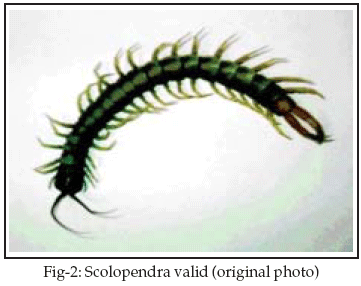|
|
||||
|
Published by : PROFESSIONAL MEDICAL PUBLICATIONS |
||||
|
ISSN 1681-715X |
||||
|
||||
|
- |
||||
|
CASE REPORT |
||||
|
- |
||||
|
Volume 23 |
October - December 2007 (Part-II) |
Number 6 |
||
|
|
||||
|
|
||||
|
|
||||
|
Published by : PROFESSIONAL MEDICAL PUBLICATIONS |
||||
|
ISSN 1681-715X |
||||
|
||||
|
- |
||||
|
CASE REPORT |
||||
|
- |
||||
|
Volume 23 |
October - December 2007 (Part-II) |
Number 6 |
||
|
|
||||
|
|
||||
Two cases of chilopoda (centipede) biting in
human from Ahwaz, Iran
Babak Vazirianzadeh1, Ali Hassan Rahmanei2, Sayed Abbas Moravvej3
SUMMARY
These are the first known case reports of biting with centipedes in the two patients from Ahwaz, Iran. Erythema has been found in both female cases. Both patients complained of pain, itching and irritation following centipede biting. Haemoglobinuria and haematuria were seen in the both cases. Both patients were bitten by Scolopendra valid (Sclopendramorpha:Sclopendridae).
KEY WORDS: Ahwaz, Chilopoda biting, Scolopendra sp.
Pak J Med Sci October - December 2007 (Part-II) Vol. 23 No. 6 956-958
1. Dr. Babak Vazirianzadeh,
Department of Medical Parasitology and Mycology,
Ahwaz Research Centre of Tropical Medicine,
2. Dr. Ali Hassan Rahmanei,
Department of Toxicology, Hospital of Razi,
3. Mr. Sayed Abbas Moravvej,
Department of Medical Parasitology and Mycology,
1-3: Ahwaz Jundishapour Medical Sciences University,
Ahwaz 61357-15768, Iran.
Correspondence
Dr. Babak Vazirianzadeh
E-mail: babakvazir@yahoo.co.uk
* Received for Publication: May 31, 2007
* Revision Received: November 12, 2007
* Revision Accepted: November 15, 2007
INTRODUCTION
Chilopoda or centipedes, which are among the less well-studied arthropods, include the true centipedes with only one pair of legs per body segment. Approximately 3000 species of centipedes are found in the class Chilopoda, phylum Arthropoda. There are 620 identified species of Scolopendromorpha including 2-3 families as the most medical importance of centipedes.
1-4 Their habitats include underground or rock piles. They are usually nocturnal arthropod predators, which are distributed widely, especially in warm, temperate and tropical regions.1,3Their first pair of appendages on the trunk is modified into a pair of claws (i.e., forcipules) with poison glands, which centipedes use to capture prey, usually other arthropods (Fig-1). The bite of large centipedes can cause some pain and discomfort in humans, although there are no authenticated cases of human fatalities from centipede bites. Common effects included intense local pain, erythema, indurations, and necrosis, as well as mild constitutional symptoms.
1,2,4The most dangerous species belong to the genus Scolopendra, with the largest members (Scolopendra gigantea) reaching lengths of 26cm. Nearly 5,000 centipede bites are reported every year in Turkey.
2 Unfortunately there is no documented report regarding centipede biting in Iran. Two cases of centipede bitings are decribed in two females from Razi University Hospital of Ahwaz (SW of Iran).CASE REPORTS
Case 1:
A 39-year-old patient presented to the emergency department with excruciating pain to her left gluteal since three days. There was a 9-10cm erythema within that area with complaint of itching and irritation. There was no pitchy or ichemosis. After arriving her pain was managed with lidocaine, a local injectable anesthetic. Physical examination revealed no blood pressure with normal heart rate, respiratory rate, temperature and oxygen saturation.

Her laboratory Prothrombin Time (PT) and Activated Partial Thromboplastin Time (APTT) examinations were normal. Rate of her hemoglobin (Hb) was normal: 10.4 and 10.8 too. Her urinalysis tests showed 1 + haemogl- obinuria during all the four tests. Haematuria were seen with an increasing rate: (4-5)-(4-6)-(10-12) and (14-15) in her urine tests too. This increasing Red Blood Cells rate may be linked with kidney disorders following centipede biting. The patient was successfully treated with oral antibiotic (ceftazidim), antihistamines and hydrocortisone and discharged a day later.
Case 2: A 40-year-old patient presented to the emergency department with excruciating pain to her right hemithorax (anterior axillary line). There was a 7-8cm erythema within that area. The patient complained of itching and irritation. There was no pitchy or ichemosis. When she arrived in hospital, her pain was managed with lidocaine. Physical examination revealed no blood pressure with normal heart rate, respiratory rate, temperature and oxygen saturation.
Her blood tests showed normal PTT and PT and varying normal rate of Hb: 12.9,12.2 and 12.1. Her urinalysis tests showed a decreasing rate of haemoglobinuria from 1+ to negative in all of her urine tests. Decrease in haematuria was seen from (8-10) to (1-2) in her urine tests too. She was hospitalized for four days and treated with oral antibiotic, antihistamines and hydrocortisone.
Identification of Centipeds: The key of Pavel Stove was used as the reference of centipede identification. Both cases were recognized as Scolopendra sp. (Sclopendromorpha: Sclopendridae) (Fig-2), using an Olympus stereomicroscope.5 Then the species was confirmed as S. valid, using key of Lewis.6 The identifications were made in the Department of Medical Parasitology and Mycology, Ahwaz Jundi Shapour Medical Sciences University.

DISCUSSION
There are numerous cases regarding centipede bites in Ahwaz hospitals which have never been considered as poisonous biting and the patients with centipede biting are discharged without any records very quickly. Centipede biting in this region can lead to some importantmedical implications like haemoglobinuria and haematuria in the patients. In addition all collected centipedes by the patients were identified as Scolopendra sp., which is the most important medical genus among centipedes. Therefore appropriate funding is required to maintain records of these important centipede bites.
The biochemistry of centipede venoms has not been studied extensively. Norris has explained that at least in some species contain 5-hydroxytryptamine, hemolytic phospholipase A and a cardiotoxic protein. Norris has also noticed that the venom of the North American giant desert centipede, Scolopendra heros, contains a cytolysin too.
1 However both serotonin and histamine, the presence of several protease-activities and non-toxic vesicating substance have been reported from the venom of Scolopendra morsitans and from body segments glands of some species like the genus Otostigmus, respectively, by Serinken et al. Other most likely, important components are present in these venoms, which require further study.2According to Serinken et. al,
2 usually Sclopendra bites produce a characteristic lesion with erythema, edema and pain that heal in a week with no complication. The inoculation of the bacteria into the subcutaneous space can also occur with no damage to the overlying skin sequencing to frank skin necrosis. These could be seen in patients with advanced age, immunosuppressive therapy, alcohol abuse, HIV infection, malignancy, diabetes mellitus, chronic renal failure or vascular insufficiency. Ozsarac et al. have reported changes in electrocardiography (ECG), which showed new ST-T wave changes, suggesting an acute ischemic process in a 60-year-old man, following a sclopendra centipede envenomation. In this case the patient experienced diaphoresis, dizziness, hypotension, and bradycardia too.7Because all centipedes captured by patients, were recognized as Sclopendra in the Department of Medical Parasitology and Mycology, therefore treatment of centipedes biting and controlling these venomous arthropods should be considered as medical care and public health, respectively.
Treatment could be divided into: pre-hospital care, emergency department care and consultations. No specific pre-hospital care has been suggested except local application of ice, heat or immersion in hot water which may reduce some of the discomforts such as pain and swelling. Emergency department cares are included: a) taking vital signs and applying routine blood and urine tests. b) reducing pain using systemic analgesics or local injectable anesthetics e.g. lidocaine or bupivacaine. c) reminding tetanus status. d) treating secondary infections with appropriate antibiotics. e) examine the wound for any signs of secondary infection or necrosis. f) observing the patients for approximately four hours for evidence of systemic toxicity. Surgical consultation for compartmental pressure testing is neccessary.
1,8,9Measures to control centipedes include the following:
*
Applying contact sprays of organo-carbamate or pyretheroid insecticides, respectively such as propoxur or pyrethrins, directly to centipedes around their habitats, for quick control.*
Spraying or dusting containing propoxur or pyrethrin around building, foundations, baseboards, cracks or other hiding places such as under clothes washers and dryers in utility rooms.*
Removing objects that provide harborage such as trash piles, rocks, boards, leaf piles, compost piles and similar materials.1,8*
Never touch or handle centipedes.*
Use caution when gardening, turning soil, or picking up rocks.*
Work gloves are very helpful in preventing bitings.1,9ACKNOWLEDGMENT
We express our thanks to Prof. S.Maraghi, head dept. of medical parasitology and mycology, Mr. A.Jelodar faculty of dept. of medical parasitology and mycology and Dr. A.Khosravi, reader of dept. of medical microbiology, School of Medicine, Ahwaz Jundi Shapour Medical Sciences University, Ahvaz, Iran for their help and assistance. Thanks are also due to Mr. A. Jelodar faculty of dept. of medical parasitology and mycology for editing the figures.
REFERENCES
1. Norris RL. Centipede envenomation. Medicine Specialties 2006;11.
2. Serinken M, Erdur B, Sener S, Kabay B, Alper CA. A case of mortal necrotizing fasciitis of the Trunk resulting from a centipede (Scolopendra moritans) Bite. Internet J Emergency Med 2005;2:2.
3. Stewart JW. Centipedes and millipedes. Extension Entomologist, The Texas A&M University System 1997.
4. Geoffroy JJ. Keys to the Myriapod. Universe and Biodiversity CIM Secretariat Centre International de Myriapoda 2005; http://www.mnhn.fr/assoc/myriapoda/KEYCLE.HTM
5. Stoev P. A catalogue and key to the centipedes (chilopoda) of Bulgaria. Pensoft, Sofia-Moscow 2002;103.
6. Lewis JGE. Centipedes of Saudi Arabia. Fauna of Saudi Arabia 1986;8:20-30.
7. Ozsarac M, Karcioglu O, Ayrik C, Somuncu F, Gumrukcu S. Acute coronary ischemia following centipede envenomation: Case Report and review of literature. Wilderness and Environmental Medicine 2001;15(2):109-12.
8. Bush SP, King BO, Norris RL, Stockwell SA. Centipede envenomation. Wilderness Environ Med 2001;12(2):93-9.
9. Ruppert EE, Barnes RD. Introduction to the Myriapoda. Invertebrate Zoology. Sixth edition. Saunders College Publishing, Fort Worth 1994;874.
HOME | SEARCH | CURRENT ISSUE | PAST ISSUES
Professional
Medical Publications
Room No. 522, 5th Floor, Panorama Centre
Building No. 2, P.O. Box 8766, Saddar, Karachi - Pakistan.
Phones : 5688791, 5689285 Fax : 5689860
pjms@pjms.com.pk